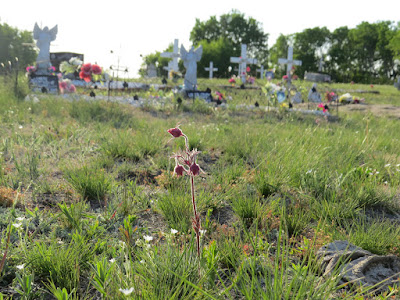 |
| sunset on the northern range at Old Man on His Back |
While Branimir was crouching over things with his camera or running to catch the last rays of magic hour, I would often take out my point and shoot and snap a few shots. This post shows a few of those moments, as well as a short video I made using clips during a tour of grassland places with ranchers and conservationists and Canadian Wildlife Services staff.
Just across the border into Manitoba there is a PFRA community pasture that contains a historic site and active cemetery where the Metis settlement of Ste. Madeleine lasted from 1880s to 1939. The local Metis still come to celebrate their culture and ties to Ste. Madeleine, as well as to bury their loved ones.
 |
| Three-flowered avens, chickweed and native grasses surround the headstones at Ste. Madeleine |
In early August we went to Caledonia-Elmsthorpe PFRA pasture--one of the prettiest pastures and only an hour south of Regina. The Saskatchewan Trails Association and Public Pastures – Public Interest sponsored a weekend of exploring the pasture on horseback and on foot. Here is a shot of Branimir with two horses and their riders (on left is Sharon Elder, the dynamo who did all the work organizing the event).
 |
| Branimir at work on Caledonia-Elmsthorpe Community Pasture |
A creek at Caledonia.
This is Nick Schmidt, the new manager at Lone Tree Community Pasture south of Val Marie right on the Montana border. Lone Tree is now managed and leased by a grazing corporation made up of former patrons. Nick lives on the property and is working with the leaseholders to manage the pasture.
 |
| Nick Schmidt, pasture manager at Lone Tree Community Pasture |
Nick was one of the many people kind enough to host those of us who were on tour sponsored by the South of the Divide Conservation Action Program (Sodcap).
SODCAP seems to have some good energy and good people on its side--I think we can expect to hear some good pilot projects coming from them in the next year.
I learned a great deal on the two days of that tour sitting between ranchers and conservationists and Canadian Wildlife Service representatives--all equally motivated to find ways to ensure our grassland species will survive in healthy populations.
This photo shows our tour surrounded by the hills of Lone Tree pasture.
 |
| Sodcap on tour at Lone Tree Community Pasture |
The day before we visited a ranch managed by Orin Balas, chair of the Prairie Conservation Action Plan. Here he is talking to Bob McLean, Executive Director at the Canadian Wildlife Service.
 |
| Rancher Orin Balas (left) and CWS Executive Director, Bob McLean |
Here is a close-up shot of speargrass and dotted blazingstar on the uplands on Orin's pastures looking south toward the Frenchman River north of Val Marie.
And here is a shot of rancher Tara Mulhern Davidson, who works for SODCAP, helping us identify grasses at Orin's place.
And here is a video showing footage from Orin's pastures and a broad valley at Lone Tree where we spent the afternoon.
And, finally, a gratuitous bluebird shot, just because.









